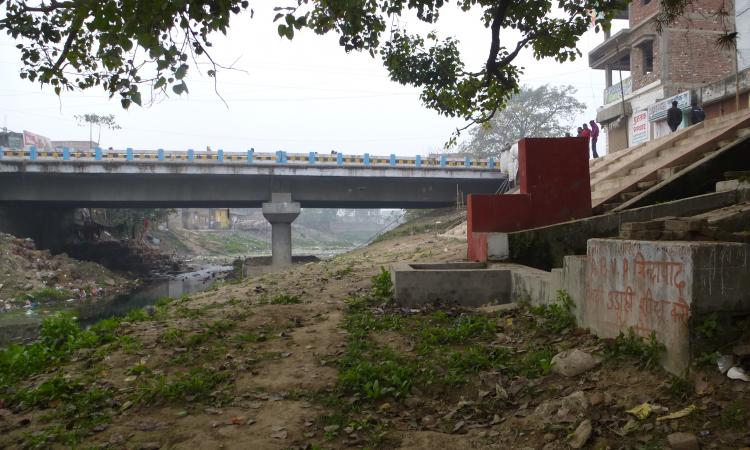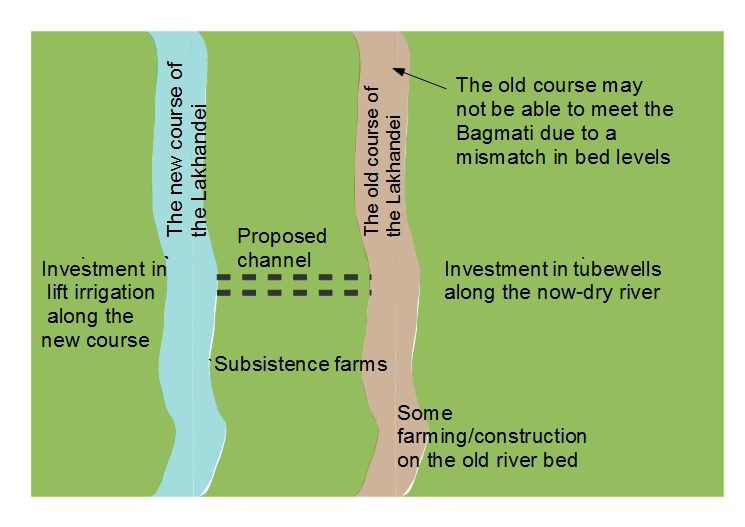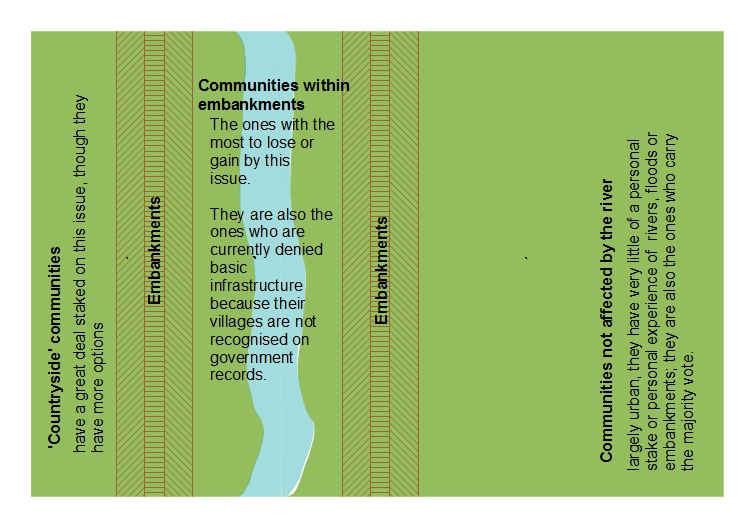
The twin sisters: Bihar is a land of fertile farms bearing sugarcane, wheat, rice, gram and pulses. Interspersed between the fields are venerable mango groves. Of Bihar's children, perhaps none is as universally loved as Sita. The village that she was born in -Sitamarhi- welcomed another daughter along with Sita. This was the Lakhandei, a river that flowed through the town till a few decades ago and is revered as Sita's sister.
The river: The Lakhandei is part of the Adhwara Group of rivers, which are the 24-odd rivers that flow down from Nepal into Bihar. The fact that the group is considered rather than the individual rivers speaks of how they continually change course.
A couple of decades ago, the Lakhandei began to change its course and stopped flowing through the town. It earlier followed a north-south orientation from Nepal through North Bihar and finally met the Bagmati, now it joins the Jhim which joins the Jhamura. The three rivers then form the Adhwara.
Sitamarhi does not use the Lakhandei's water for drinking; the town relies on groundwater for its domestic use. Now that the Lakhandei has begun to flow in another channel, the old channel contains unadulterated sewage. This is a strong incentive for the devout Hindus of Sitamarhi to clamour for the return of their holy river.
At the same time, there is now a plan to enclose the Jhim-jhamura within embankments. This has triggered a heated protest in the district. Embankments tend to be violently opposed by people who have experienced living with them. They claim with reason that embankments hinder the flow of water across the land and so lengthen the duration of the very floods that they are meant to prevent.
A group of activists in Sitamarhi led by Shashi Shekhar have two demands:
- Stop constructing embankments on the Jhim and Jhamura rivers
- Divert the Lakhandei from its new course to the old.
According to Shekhar, the Jhim-Jhamura rivers do not have water in it, but only get water when the Lakhandei's flows join it. If the Lakhandei is diverted to its old course, there will be no water in the Jhim-jhamura, and so no need for embankments.
The proposed rediverting of the Lakhandei to its old course is at a village near Sonbarsa. Here the old and the new courses are a scant 1.5 km away from each other. The proposers say that they can be connected by digging a canal. This canal, combined with the desilting of the Lakhandei's bed at Sitamarhi should rewind the clock by 20 years, with no harm to anyone, they say. However, the reality is a little more complex.
Let us first examine the physical possibility of this diversion.
A herculean task: The place identified for the channel connecting the old and the new river courses is more than a proposed construction site; it is a series of fertile farms growing sugarcane and pulses. An openly hostile farmer said, "We know what you are doing here. You have come to take away our fields. We will not allow this". Even the minimum amount of land needed to excavate the channel will mean a sizeable portion of these poor farmers' lands.
Balaji, Shekhar's son, claims that the government will take care of compensation for land. But the state governments have been notoriously lax in paying out compensation, a fact that Shekhar's team are well aware of; they have been agitating- not very successfully- to ensure that farmers are given the compensation due to them for embankments and bridges built earlier.
In the last 20 years, people along the banks of the old and new courses have also adapted to their new state; those along the old course have moved away from their dependence on river flows and are using groundwater for irrigation, conversely, those living along the new course have now taken up irrigation with river water. Changing courses again will severely disrupt their lives. To reverse the flow will mean negating the investments of each of these groups. The people living along the banks of both the old and new courses are nearly without exception marginal farmers. A loss of this investment is a serious setback.
The situation is very similar to that in the town of Sitamarhi. In the 20 years since the river began to flow in a separate channel, Sitamarhi has swallowed the channel. A young man called Sandeep (last name not given), pointed out that it is not only the illegal construction in the river bed that is at risk but also the foundations of many of the houses that have come up along the river banks.
The other problem is that of bed levels. The Lakhandei changed its course because the old bed silted up. The present demands are to rectify this problem by desilting the old bed of the Lakhandei. However, the executive committee nominated to examine the issue reports that in the 20 years that the Lakhandei has been slowly raising its bed levels, the Bagmati has been doing the same. If the old bed of the Lakhandei is desilted till it reaches the level it was 20 years ago, it will be below the Bagmati's bed level at the point of confluence. This, then becomes an ever-increasing problem. Desilting the Bagmati- a task of phenomenal magnitude- will mean that it is below the Ganga at its point of confluence. Desilting the Ganga is herculean indeed.
The dilemma: Even if it were possible, stopping construction of embankments on the Jhim-jhamura by depriving them of water is a problematic approach as it implies that a river without water is desirable.
The assertion of those who are agitating for the Lakhandei to be diverted back to its old bed is that if there is no water in the Jhim, it will never flood and this will negate any need for an embankment. This is a dangerous statement, because it can be argued that the converse is also true: that where there is water, there must be embankments.
Historically, this technocratic view of rivers has led to distress and mayhem. Far more dangerous is the implication that to do away with problems is to do away with river flows.
The rhetoric that a 'safe' river is one that does not have water in it is being used to justify the construction of dams in the Himalayas and excessive withdrawal from rivers across the world. In this context, a statement such as this one coming from a group of 'river activists' can be excessively damaging.
What happens next: Not one of the people I spoke with, whether farmers, activists, or academicians could predict a time when the Government of Bihar would rein in its plans of constructing embankments along rivers. Despite the local opposition to the embankments, despite the repeated incidents where groups of enraged villagers take pickaxes to destroy embankments, despite the annual story of floods that are exacerbated by embankments, the construction of these will go on.
The reason for this, explained by an academician who requested anonymity, is money. “Construction, today, is Bihar's fastest growing sector with a growth rate of 26%. It is also highly politicised, with the contractors and politicians working closely together and supporting each other”, he said. Given this context, it is not difficult to understand why the government of Bihar will never pull the stops on this highly lucrative industry. That is a reality, and one that is acknowledged by all those I spoke with.
Construction of embankments is more a political than an engineering decision, driven by votes rather than by mathematics. "The solution, in this case, needs to be arrived at through a democratic process", said Anindo Banerjee of PRAXIS, an organisation working on human rights in Bihar. To understand this, we need to look at the electorate of Bihar. From the point of view of their attitude towards embankments, they can be classified into three groups:
- people living within the embankment
- people living in the 'countryside' or just beyond the embankment
- people living far away from the river and its embankments

Banerjee advocates the redrawing of electoral boundaries in such a manner that people living within the embankments have a vote of their own. The problem of course, is that of motivating the government to give these conveniently silent groups a voice.
Till then, we have no option but to deal with conflicts and struggles over individual embankments and individual rivers.